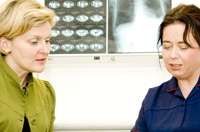Death rates from ovarian cancer have fallen by 20 per cent over last decade

The rates of women dying from ovarian cancer in England have fallen from 11.2 women in every 100,000 (3,820 cases) in 2001 to 8.8 per 100,000 (3,453 cases) in 2010 – a drop of around 20 per cent, according to a new report by the National Cancer Intelligence Network published today.
And the most notable drop in deaths over the last 10 years has been among women aged 40-69 years old.
The report also showed that survival for ovarian cancer has increased since the mid-1980s – women surviving their disease for at least a year has risen from 57 to 73 per cent and five year survival has increased from 33 to 44 per cent.
But the report found the chance of surviving the disease varies widely between ages, becoming increasingly worse with age, even after adjusting for the higher background mortality in the older population generally. For women aged 15-39 diagnosed with ovarian cancer, 84 per cent survived their disease for at least five years compared with just 14 per cent of those aged over 85 years at diagnosis.
In 2009 almost half of women diagnosed with ovarian cancer were in their 60s or 70s – and over 80 per cent of deaths were in women aged 60 or over.
Dr Andy Nordin, gynaecological oncologist at East Kent Hospitals University NHS Foundation Trust and study author, said: "Our new report is very encouraging and shows a fall in the rates of women dying from ovarian cancer – a type of cancer that has always been notoriously hard to treat. This is because ovarian cancer is a group of different disease types, which is difficult to diagnose and commonly presents as advanced disease. This drop in deaths may reflect improvements in detecting and treating the disease, such as improvements in scanning, surgery and chemotherapy treatments. Additionally, over the past decade, ovarian cancer patients throughout the UK have experienced better management due to organisation of ovarian cancer care in specialist gynaecological cancer centres, planning of care by teams of cancer experts and specialist surgery by specially trained and accredited gynaecological oncologists."
The report also highlights that the incidence rates for developing the disease have remained fairly stable since the late 1980s although they have dropped slightly in the last few years.
Dr Nordin, added: "We know the risk of developing some types of ovarian cancer may be related to the number of times a women ovulates during her lifetime. And anytime that she stops ovulating such as during pregnancy and breast feeding, early menopause and taking the contraceptive pill all help to protect against the disease developing. The fall in incidence could therefore partially reflect the widespread use of hormonal contraceptives since the '60s."
Chris Carrigan, head of the National Cancer Intelligence Network (NCIN), said: "As ovarian cancer can be very hard to diagnose and treat this report was important to help us learn as much as we can about the numbers of women who develop the disease, how many survive and how many die."
Ovarian cancer is the fifth most common cancer in women in the UK with around 7,000 cases diagnosed each year.
More information: Overview of Ovarian Cancer in England: Incidence, Mortality and Survival, November 2012, Trent Cancer Registry National Cancer Intelligence Network (NCIN).

















